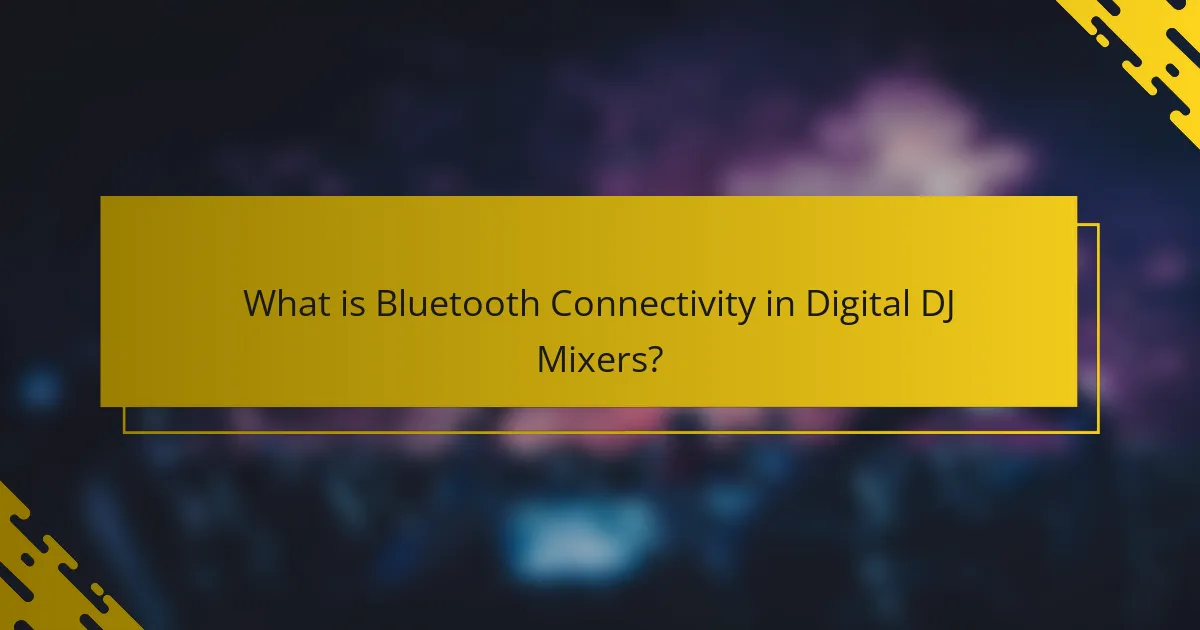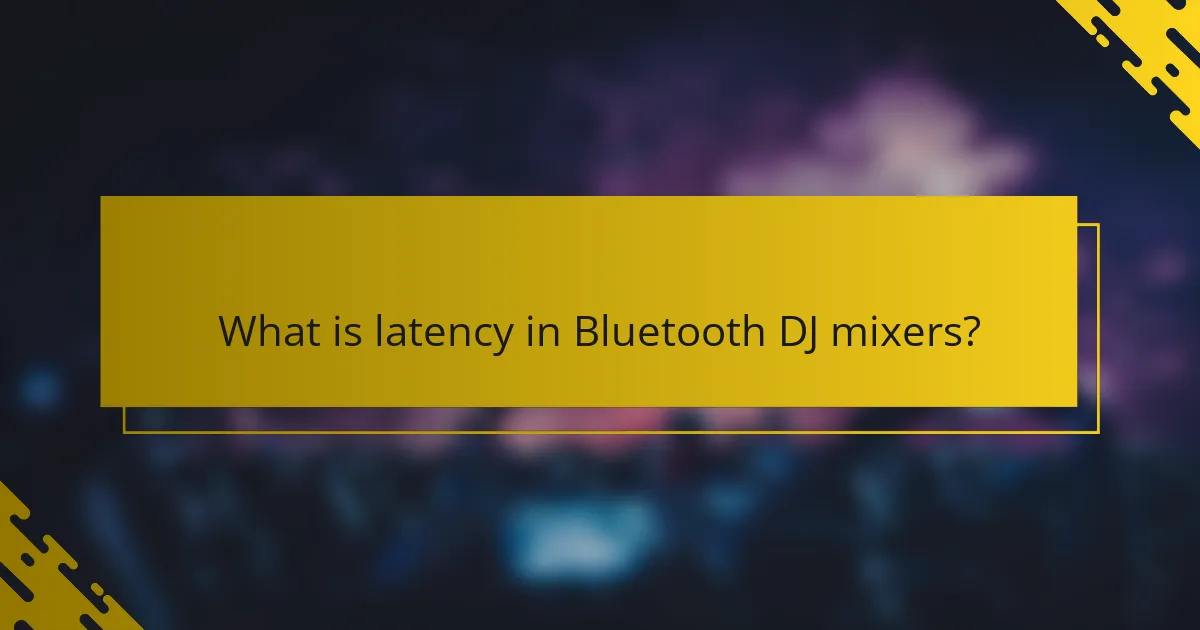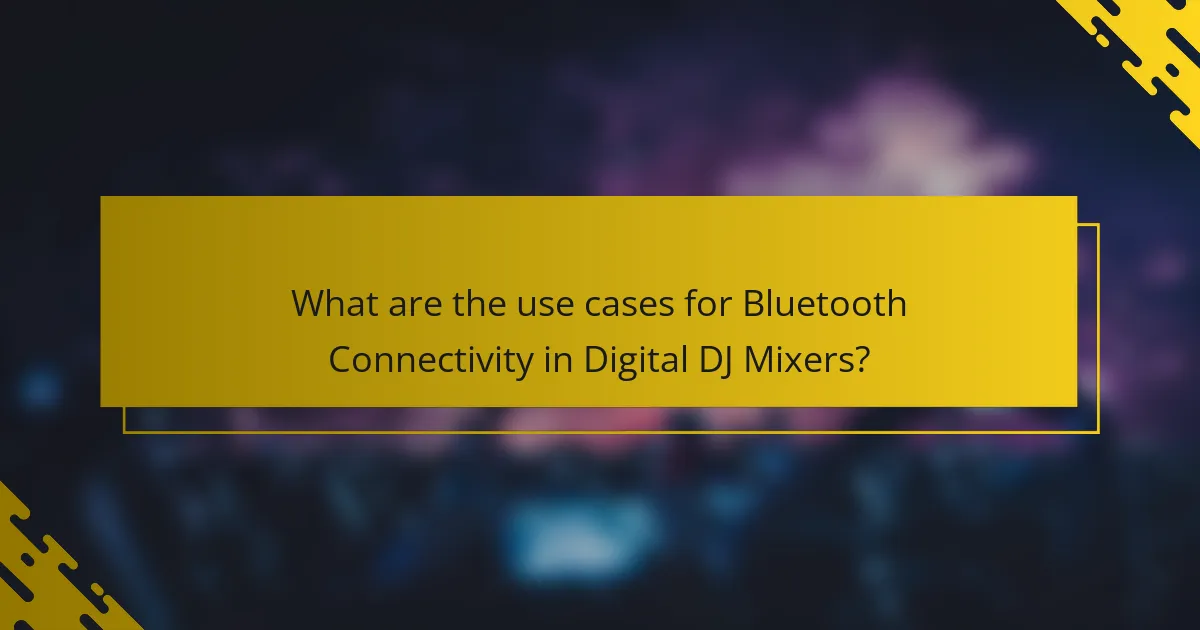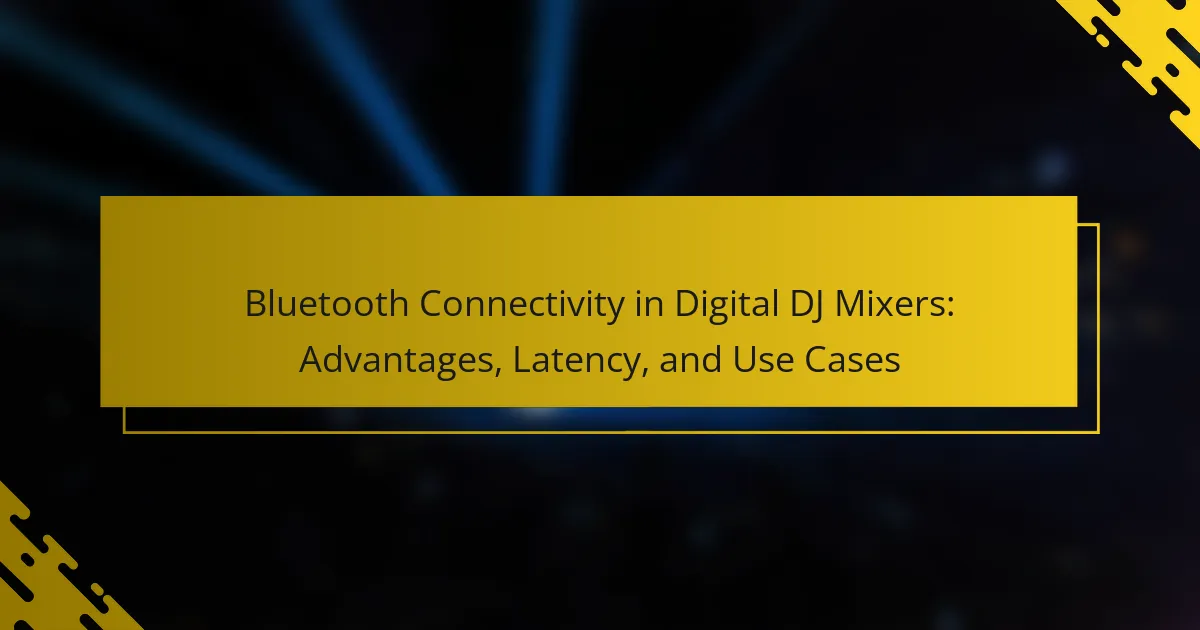Bluetooth connectivity in digital DJ mixers enables wireless audio streaming from devices such as smartphones, tablets, and laptops, enhancing mobility and simplifying setup during performances. This technology typically operates within a range of about 30 feet and supports Bluetooth versions 4.0 and above for better stability and sound quality. While Bluetooth offers advantages like easy collaboration and integration with wireless headphones, it also introduces latency, which can range from 30 to 200 milliseconds, potentially impacting live performance. Understanding latency is essential for DJs to achieve optimal audio synchronization. Overall, Bluetooth connectivity significantly increases the versatility and convenience of digital DJ mixers, accommodating various performance styles and setups.

What is Bluetooth Connectivity in Digital DJ Mixers?
Bluetooth connectivity in digital DJ mixers allows wireless audio streaming from devices. This technology enables DJs to connect smartphones, tablets, or laptops without physical cables. It simplifies setup and enhances mobility during performances. Bluetooth typically operates within a range of about 30 feet. Many modern mixers support Bluetooth versions like 4.0 and above for improved stability and sound quality. This connectivity option is particularly useful for playing back tracks or samples on the fly. Additionally, it can facilitate easy collaboration with other artists. Overall, Bluetooth enhances the versatility and convenience of digital DJ mixers.
How does Bluetooth Connectivity enhance digital DJ mixers?
Bluetooth connectivity enhances digital DJ mixers by enabling wireless audio streaming. This feature allows DJs to connect devices like smartphones and tablets without cables. Wireless connections reduce setup time and eliminate cable clutter. Bluetooth technology supports high-quality audio streaming, maintaining sound fidelity. It also allows for seamless integration of various music sources. DJs can easily switch between tracks from different devices. Additionally, Bluetooth connectivity facilitates remote control of mixer functions. This enhances flexibility during live performances. Overall, Bluetooth connectivity modernizes the DJing experience with convenience and efficiency.
What are the key features of Bluetooth technology in DJ mixers?
Bluetooth technology in DJ mixers offers several key features. It enables wireless audio streaming from devices such as smartphones and tablets. This feature allows DJs to play music without the need for physical cables. Bluetooth connectivity also supports multiple device pairing. This means DJs can switch between devices effortlessly during performances.
Another important feature is low latency audio transmission. Many modern DJ mixers minimize delay, ensuring synchronized sound output. Additionally, Bluetooth mixers often include built-in controls for easy access to audio settings. This integration enhances user experience and flexibility.
Moreover, Bluetooth technology facilitates remote control capabilities. DJs can adjust settings from a distance, improving stage mobility. Overall, these features enhance the versatility and convenience of DJ mixers in live settings.
How does Bluetooth connectivity compare to traditional wired connections?
Bluetooth connectivity offers wireless convenience, while traditional wired connections provide stable and high-quality audio. Bluetooth has a range of about 30 feet, allowing for flexibility in setup. Wired connections, on the other hand, typically deliver superior sound quality with lower latency. Bluetooth audio can experience delays, impacting live performances. Wired connections eliminate this latency, ensuring real-time sound transmission. Bluetooth devices may face interference from other wireless signals, whereas wired connections remain unaffected. Overall, Bluetooth is ideal for mobility, while wired connections are preferred for reliability and audio fidelity.
What advantages does Bluetooth Connectivity provide for DJs?
Bluetooth connectivity offers DJs increased flexibility and convenience. It allows wireless connection to audio sources, eliminating the need for cumbersome cables. This enhances mobility during performances. DJs can easily switch between devices without physical connections. Bluetooth also facilitates quick setup and teardown of equipment. Additionally, it enables streaming from smartphones or tablets seamlessly. The technology supports multiple audio formats, ensuring compatibility with various devices. Overall, Bluetooth connectivity streamlines the DJing process, improving efficiency and performance quality.
How does Bluetooth improve mobility for DJs during performances?
Bluetooth enhances mobility for DJs during performances by allowing wireless connections between devices. This technology enables DJs to move freely without being tethered to their equipment. They can control mixers, effects, and playlists from a distance. The range of Bluetooth typically extends up to 100 meters, providing significant flexibility. DJs can interact with the audience or adjust settings while moving around. Wireless headphones also allow for monitoring without physical constraints. This mobility can lead to more dynamic performances. According to a study by the Journal of Audio Engineering, wireless setups are increasingly preferred for their convenience and versatility.
What are the cost benefits of using Bluetooth-enabled DJ mixers?
Bluetooth-enabled DJ mixers reduce costs by minimizing the need for extensive cabling and adapters. This wireless technology simplifies setup and teardown processes. DJs save on equipment costs by eliminating the need for additional hardware. The convenience of Bluetooth also decreases time spent on technical issues related to connections. According to industry reports, wireless setups can lower labor costs during events. Bluetooth mixers often come with built-in features that negate the need for extra gear. This integration can lead to overall budget savings for both professionals and hobbyists.
What are the potential drawbacks of Bluetooth Connectivity in DJ mixers?
Bluetooth connectivity in DJ mixers can introduce several potential drawbacks. One major issue is latency, which can cause delays between audio input and output. This delay can disrupt the timing of mixes, making it challenging for DJs to synchronize tracks effectively.
Another drawback is the potential for audio quality degradation. Bluetooth compression may reduce sound fidelity compared to wired connections. Additionally, Bluetooth connections can be less stable, leading to dropouts or interruptions during performances.
Interference from other wireless devices can also impact connectivity. This interference can result in inconsistent performance, particularly in crowded environments. Lastly, not all Bluetooth-enabled mixers support all audio formats, limiting compatibility with certain devices.
How does latency affect performance in Bluetooth DJ setups?
Latency negatively impacts performance in Bluetooth DJ setups. It creates a delay between audio input and output. This delay can disrupt timing during live performances. DJs rely on precise synchronization of beats and samples. If latency is too high, it can lead to noticeable lag. This lag can affect mixing and cueing tracks effectively. Studies indicate that acceptable latency for DJs is around 10-20 milliseconds. Anything above this may result in a poor user experience. Therefore, minimizing latency is crucial for optimal performance in Bluetooth DJ setups.
What are the common connectivity issues DJs might face?
DJs commonly face connectivity issues such as signal interference, latency, and device compatibility. Signal interference occurs when multiple devices operate on the same frequency. This can disrupt audio quality and cause dropouts. Latency refers to the delay between audio input and output, which can hinder live performance. Device compatibility issues arise when mixers do not support certain Bluetooth profiles. Additionally, connection stability can be affected by distance from the source device. These issues can lead to interruptions during a set, impacting overall performance.

What is latency in Bluetooth DJ mixers?
Latency in Bluetooth DJ mixers refers to the delay between the audio signal being transmitted and its playback. This delay can affect performance, particularly in live settings. Bluetooth technology typically introduces a latency of 30 to 200 milliseconds. Higher latency can result in noticeable timing issues during mixing or beatmatching. Audio professionals often prefer lower latency for seamless audio synchronization. Some Bluetooth DJ mixers feature low-latency codecs to minimize these delays. Understanding latency is crucial for DJs to ensure optimal performance.
How is latency measured in Bluetooth audio devices?
Latency in Bluetooth audio devices is measured as the time delay between audio input and output. This delay is typically quantified in milliseconds (ms). Measurement can be conducted using specialized software or tools that analyze the audio signal path.
Test setups often involve sending a known audio signal through the Bluetooth device and recording the output. The time difference between the input and the recorded output is calculated to determine latency.
Common values for Bluetooth audio latency range from 30 ms to 300 ms, depending on the codec and device used. For instance, aptX Low Latency codec can achieve around 40 ms. This measurement is crucial for applications like digital DJ mixers, where real-time audio synchronization is essential.
What factors contribute to latency in Bluetooth DJ mixers?
Latency in Bluetooth DJ mixers is influenced by several factors. The primary factor is the Bluetooth codec used for audio transmission. Different codecs have varying levels of compression and processing time. For example, aptX offers lower latency compared to standard SBC codecs.
Another factor is the distance between the mixer and the Bluetooth source. Increased distance can lead to signal degradation and higher latency. Interference from other wireless devices can also contribute to latency. This interference disrupts the Bluetooth signal, causing delays in audio transmission.
The processing power of the DJ mixer plays a role as well. Mixers with higher processing capabilities can manage audio data more efficiently, reducing latency. Additionally, the quality of the Bluetooth hardware impacts latency. Superior hardware can handle data transfer more effectively, minimizing delays.
Lastly, the audio settings and configurations of the mixer can affect latency. Higher sample rates and bit depths can introduce additional processing time, leading to increased latency.
How can DJs minimize latency during live performances?
DJs can minimize latency during live performances by using wired connections instead of Bluetooth. Wired connections typically offer lower latency compared to wireless options. Additionally, DJs should utilize high-quality audio interfaces designed for minimal delay. Keeping software and firmware updated can also reduce latency issues. DJs should avoid using multiple Bluetooth devices simultaneously, as this can increase latency. Adjusting buffer sizes in DJ software settings can help optimize performance. Finally, selecting equipment specifically designed for low-latency performance is crucial. These steps collectively enhance the responsiveness of audio playback during live sets.
Why is latency a critical consideration for DJs?
Latency is a critical consideration for DJs because it affects the timing and synchronization of audio signals. High latency can lead to noticeable delays between the DJ’s actions and the sound output. This delay disrupts the flow of a performance and can confuse both the DJ and the audience. For instance, in live settings, a latency of more than 10 milliseconds is often perceptible and can hinder a DJ’s ability to beat-match tracks effectively. Additionally, precise timing is essential for seamless transitions and maintaining the energy of a set. Therefore, minimizing latency ensures that DJs can perform at their best and deliver an engaging experience.
How does latency impact the overall DJing experience?
Latency significantly impacts the overall DJing experience by introducing delays between audio input and output. This delay can disrupt the timing and synchronization essential for seamless mixing. DJs rely on precise timing to beat-match tracks and create smooth transitions. High latency can lead to noticeable lags, making it difficult to perform live. Research indicates that latency above 10 milliseconds can negatively affect a DJ’s ability to mix effectively. In practical terms, this means that DJs may struggle to maintain rhythm and flow during performances. Consequently, low-latency connections are crucial for optimal DJing, ensuring real-time responsiveness and enhancing the overall performance quality.
What are the acceptable latency levels for live performances?
Acceptable latency levels for live performances typically range from 5 to 10 milliseconds. Latency above 10 milliseconds can result in noticeable delays that affect performance quality. In professional settings, maintaining latency under 5 milliseconds is ideal for real-time interactions. Studies show that human perception of latency becomes critical at around 20 milliseconds. This means performers may struggle to synchronize with audio cues at higher latency levels. Therefore, minimizing latency is essential for a seamless live experience.

What are the use cases for Bluetooth Connectivity in Digital DJ Mixers?
Bluetooth connectivity in digital DJ mixers allows for wireless audio streaming and device pairing. DJs can connect their smartphones or tablets to play music directly from their devices. This feature enhances mobility by eliminating the need for physical cables. Bluetooth also facilitates easy integration with wireless headphones for monitoring. Additionally, it enables quick setup and teardown of equipment at events. DJs can use Bluetooth to connect to various devices, such as controllers and effects units. This versatility supports a range of performance styles and setups. Overall, Bluetooth connectivity enhances the flexibility and convenience of digital DJ mixers.
How are DJs utilizing Bluetooth technology in various settings?
DJs are utilizing Bluetooth technology to enhance their performances and streamline setups. They connect devices wirelessly to eliminate cable clutter. This allows for greater mobility on stage. DJs can use Bluetooth speakers for playback without physical connections. Additionally, they can sync multiple devices for collaborative mixing. Bluetooth technology also enables DJs to control software remotely. This is particularly useful in large venues. The ability to connect smartphones for music streaming is another advantage. These applications demonstrate the versatility of Bluetooth in various DJ settings.
What are the best practices for using Bluetooth in live performances?
The best practices for using Bluetooth in live performances include ensuring a stable connection, minimizing latency, and maintaining device compatibility. A stable connection can be achieved by keeping the Bluetooth range within 30 feet and avoiding physical obstructions. Minimizing latency is crucial; aim for devices with low-latency codecs like aptX. Maintaining device compatibility involves using equipment that adheres to common Bluetooth profiles, such as A2DP for audio streaming. Regularly updating firmware on Bluetooth devices can enhance performance and security. Additionally, conducting a pre-show test of the Bluetooth setup can help identify potential issues. These practices help ensure a smooth and professional live performance.
How do different genres of music influence Bluetooth usage in DJ setups?
Different genres of music influence Bluetooth usage in DJ setups through varying requirements for audio quality and latency. For instance, electronic dance music (EDM) often demands low latency for seamless beat matching. DJs in this genre typically prefer Bluetooth devices with advanced codecs that reduce delay. Conversely, genres like jazz or classical may tolerate higher latency due to less reliance on beat synchronization. These DJs might prioritize audio fidelity over latency, opting for high-quality Bluetooth speakers. Research indicates that genres with complex arrangements benefit from stable connections to maintain sound integrity. Bluetooth technology continues to evolve, impacting how DJs adapt to genre-specific demands.
What are the future trends for Bluetooth Connectivity in DJ mixers?
Future trends for Bluetooth connectivity in DJ mixers include enhanced audio quality and reduced latency. Manufacturers are focusing on adopting advanced Bluetooth codecs like aptX and AAC. These codecs improve sound fidelity, making wireless connections more reliable. Additionally, integration with mobile apps is becoming more common. This allows DJs to control settings and access music libraries remotely. Another trend is the development of multi-device connectivity. DJs can connect multiple devices simultaneously for seamless performance. The push for longer battery life in mixers is also notable. This ensures extended use during events without interruptions. Overall, these trends are driven by the demand for flexibility and convenience in live performances.
How is technology evolving to enhance Bluetooth performance in audio devices?
Technology is evolving to enhance Bluetooth performance in audio devices through advancements in codecs and hardware. New audio codecs like aptX Adaptive and AAC provide higher quality sound and lower latency. These codecs improve audio streaming by optimizing data transmission based on connection quality. Additionally, Bluetooth 5.0 and later versions offer increased range and speed. This allows for more stable connections and better performance in crowded environments. Manufacturers are also integrating advanced antenna designs to boost signal strength. These developments lead to clearer audio and reduced dropouts. Enhanced Bluetooth performance is crucial for applications in digital DJ mixers, where sound quality and reliability are essential.
What innovations can we expect in Bluetooth DJ mixers in the coming years?
Innovations in Bluetooth DJ mixers will likely include enhanced audio quality and reduced latency. Future models may incorporate advanced codecs for superior sound fidelity. Improved battery life will be another focus, allowing longer performance times. Seamless integration with mobile devices is expected to enhance user experience. New features may include smart effects and AI-driven mixing capabilities. Additionally, more robust wireless connections will improve reliability in live settings. Innovations in user interfaces may simplify navigation and control. Finally, increased compatibility with various software platforms will broaden functionality.
What tips can DJs follow for effective Bluetooth Connectivity?
DJs can follow several tips for effective Bluetooth connectivity. First, ensure that devices are within a close range to minimize signal interference. Obstacles like walls or large objects can weaken the Bluetooth signal. Second, keep Bluetooth firmware updated on all devices. This can enhance performance and reduce connectivity issues. Third, avoid pairing multiple devices simultaneously, as this can create confusion and lag. Fourth, use devices that support the latest Bluetooth standards, such as Bluetooth 5.0, for improved range and stability. Finally, perform a connectivity test before a set to ensure everything functions correctly. These practices help maintain a stable and reliable connection during performances.
What troubleshooting steps should DJs take for Bluetooth connection issues?
DJs should follow specific troubleshooting steps for Bluetooth connection issues. First, ensure that both the DJ equipment and the Bluetooth device are powered on. Next, check that Bluetooth is enabled on both devices. Verify that the devices are within the recommended range, typically around 30 feet. Remove any potential interference from other electronic devices. Restart both the DJ equipment and the Bluetooth device to refresh the connection. If issues persist, forget the device in the Bluetooth settings and re-pair it. Finally, consult the user manual for specific troubleshooting tips related to the equipment model. These steps are effective in resolving common Bluetooth connectivity problems.
How can DJs ensure optimal performance when using Bluetooth technology?
DJs can ensure optimal performance when using Bluetooth technology by minimizing latency and ensuring a strong connection. They should choose high-quality Bluetooth devices that support low-latency codecs like aptX. Maintaining proximity to the Bluetooth source reduces interference and signal dropouts. DJs should also update firmware regularly to enhance compatibility and performance. Using dedicated Bluetooth transmitters can improve audio quality over built-in options. Testing the setup before a performance helps identify potential issues. According to a study by the Journal of Audio Engineering Society, latency can significantly affect live performance, making these precautions essential.
Bluetooth connectivity in digital DJ mixers enables wireless audio streaming, facilitating connections to devices like smartphones and tablets without the need for physical cables. This technology enhances mobility and simplifies setup, allowing DJs to switch between devices effortlessly and control mixer functions remotely. Key features include low latency audio transmission, multiple device pairing, and built-in controls for improved user experience. While Bluetooth offers advantages such as cost savings and flexibility, it also presents challenges like potential latency issues and audio quality degradation compared to traditional wired connections. The article explores these aspects, highlighting the advantages, drawbacks, and practical applications of Bluetooth technology in DJ performances.
